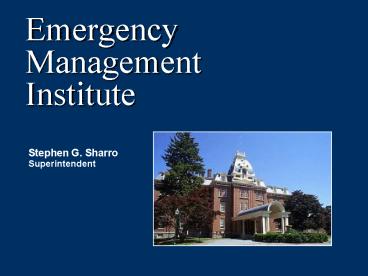Emergency Management Institute - PowerPoint PPT Presentation
1 / 32
Title:
Emergency Management Institute
Description:
Games. We learn by making mistakes NOT by getting everything right ... Materials downloadable from Internet. Training Strategy. Distance. Learning. National ... – PowerPoint PPT presentation
Number of Views:31
Avg rating:3.0/5.0
Title: Emergency Management Institute
1
Emergency Management Institute
Stephen G. Sharro Superintendent
2
Vision
- The Emergency Management Institute (EMI) supports
the Department of Home-land Securitys (DHS)
goals by improving the skills of U.S. officials
at all levels of government to prevent, prepare
for, respond to, recover from, and mitigate the
potential effects of all types of disasters and
emergencies.
3
Goals
- Improve the abilities of FEMA and other DHS
employees - Improve the abilities of U.S. state, local, and
tribal officials by - Directly training state, local, and tribal
employees in selected subjects - Enabling state, local, and tribal officials to
develop and deliver training for their own
constituents - Enhance the preparedness of U.S. individuals,
families, and special audiences through training
4
EmergencyManagementInstitute
Preparedness
Disasters Operations Recovery
Mitigation
Superintendent
Distance Learning
Integrated Emergency Management
Employee Development
5
FEMA Training Activities
National Emergency Training Center Emmitsburg
Noble Training Center Anniston
6
FEMA RegionsRegional Training Managers
FEMA Training Activities
7
Emergency Management InstituteCore Training
Values
- Inherent dignity of all learners
- Performance-based NOT content-based
- Learning by doing NOT teaching by telling use
- Case studies
- Exercises
- Games
- We learn by making mistakes NOT by getting
everything right - Exploit technology when appropriate
- Make learning--and teachingfun
- Really use evaluation
- Take student opinion surveys with a grain of salt
- Use discriminating evaluation of student
performance - NOT to fail students, but to get meaningful
feedback
8
Employee DevelopmentProgram
- FEMA Orientations
- Computer training
- Job-specific training
- Secretarial Development
- Management Leadership Development Training
- Executive Training
9
Emergency Management Institute
Employee Development Training for FEMA Personnel
10
Emergency Management InstituteResponsibilities
- Determine training needs--all audiences
- Acquire or develop appropriate training
- Deliver training
- Evaluate results
- Revise as appropriate
- Support local exercising
11
Training Needs
12
Geography
13
Hazards
14
Training Strategy
15
Resident Training
- Last resort most costly
- Only training that cant be done some other way
- Train-the-trainer courses
- Training for EPR/FEMA employees
- Specialized courses with small audiences
- Courses requiring special equipment or facilities
- More than 10,000 enrollments in Fiscal Year 2004
- Stipend program
16
Resident Enrollments1995-2004
EMI
10,301
17
Training Strategy
18
Field Training
- Courses designed and developed at EMI
- Hand-off materials include
- Student manual
- Instructor guides
- Training aids
- EMI Training Network
- Delivered in all 50 states
- State instructors trained by EMI
- Materials downloadable from Internet
19
Training Strategy
20
Distance Learning
- Emergency Education
- Network
- NETC Virtual Campus
- 44 EMI courses
- FEMA Employee Knowledge
- Center
- Internet-based Courses
21
Independent Study ProgramCompletions1995-2005
EMI
22
Training Strategy
23
Exercise Support
- Exercises provide best training
- Goal is to enable local official to exercise
- FEMA support Exercise Training Officer in every
state - Comprehensive Exercise Curriculum
- Design
- Conduct
- Evaluate results
- Implement corrective actions
24
Training Strategy
25
EMI Training Strategy
26
Preparedness Courses
- Incident Command / NIMS
- Planning
- Evacuation
- Hazardous Materials
- Earthquake
- Terrorism
27
Mitigation Courses
- Flood and Floodplain Management
- Earthquake/Hurricane Mitigation
- School Safety
- Multihazard Building Design Summer Institute
- Community Emergency Response Team
- Schools Programs
28
Disaster Operations Recovery Courses
- Disaster Response Operations
- Disaster Operations Leadership
- Managing EPR/FEMA Staff in Disasters
- Disaster Recovery Operations/Programs
- Disaster Field Training Organization--Just-in-Time
training at Joint Field Offices
29
Integrated Emergency Management Course
- 5-day resident course
- Focus on integrated response
- Exercise-based
- Participants selected based on positions
- Versions
- Community-specific
- Hazard-specific
30
EMI Master Trainer Program
- Courses
- Training management
- Needs analysis
- Instructional design
- Course development
- Instructional delivery
- Evaluation (on-line)
- Practicum
- For emergency management training officers
- Based on instructional system design model (ISD)
- Students projects become EMI courses
31
(No Transcript)
32
(No Transcript)






























![National Institute of Technology - [NITKKR], Kurukshetra PowerPoint PPT Presentation](https://s3.amazonaws.com/images.powershow.com/9683358.th0.jpg?_=20211114015)
